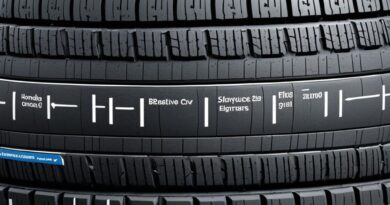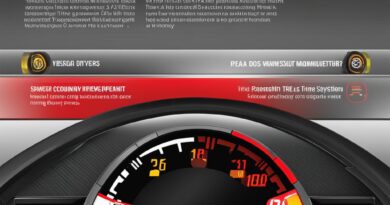How to Check Tire Pressure on Honda Accord Safely
Maintaining proper tire pressure is a critical aspect of car maintenance, often overlooked by drivers. For Honda Accord owners, routinely checking tire pressure between service department visits is essential. Although this task is simple, it must be done correctly to ensure vehicle safety and efficiency. Using a reliable tire pressure gauge and access to compressed air, along with your ignition key, you can perform these checks yourself. Ignition should be turned on, without starting the engine, to allow the Tire Pressure Monitoring System (TPMS) to indicate low pressure via a warning light. Manual pressure checks are necessary for each tire, followed by adjustments using an air source. The recommended tire pressure is readily found on a label inside the driver’s door for optimal performance. Regular checks should coincide with fuel fill-ups or, at a minimum, on a monthly basis and with seasonal temperature changes.
Key Takeaways
- Regularly checking tire pressure on your Honda Accord ensures safety and efficiency
- Use a reliable tire pressure gauge and access to compressed air for accurate measurements
- Turn the ignition to the ‘accessory mode’ to activate the Tire Pressure Monitoring System (TPMS) warning light
- Check each tire individually and adjust the pressure using an air source if necessary
- The recommended tire pressure for your Honda Accord can be found on a label inside the driver’s door
- Perform tire pressure checks at least once a month and with seasonal temperature changes
Understanding the Importance of Correct Tire Pressure in Honda Accord
The correct tire pressure in a Honda Accord plays a pivotal role in ensuring vehicle safety and optimal efficiency. Not only does it contribute to even tire wear and longevity, but it also impacts overall ride quality and fuel economy. The Honda Accord’s tire pressure monitoring system (TPMS) is an essential tool for assisting drivers in maintaining the right tire pressure.
The Role of Tire Pressure in Vehicle Safety and Efficiency
Proper tire pressure is an essential aspect of vehicle safety, as it affects a vehicle’s handling, braking, and stability. Furthermore, maintaining the recommended tire pressure for your Honda Accord can help improve fuel efficiency and extend the life of your tires. Uneven tire wear can lead to reduced traction, decreased fuel efficiency, and, ultimately, the need for premature tire replacement.
Unveiling the Honda Accord Tire Pressure Monitoring System (TPMS)
The TPMS of a Honda Accord is designed to alert drivers when tire pressure deviates from the recommended level. An amber-colored light illuminates on the instrument cluster when low pressure is detected, serving as a visual reminder to check and adjust tire pressure accordingly. TPMS technology relies on ABS sensors, among other parameters, to track these deviations without the need for pressure sensors within the tire, a feature appreciated by drivers of 2022 models like the Accord EX-L and hybrid variants.
Understanding and responding to TPMS alerts is essential for maintaining proper tire pressure in your Honda Accord. By routinely checking your tires and making necessary adjustments, you can ensure the safety, performance, and longevity of your vehicle.
Preparations for Tire Pressure Maintenance
Before beginning the process of monitoring and maintaining tire pressure for your Honda Accord, it’s crucial to have the appropriate tools and knowledge. Equipping yourself with a high-quality tire pressure gauge and access to compressed air will ensure accurate pressure readings and adjustments. Moreover, identifying the correct tire pressure specific to your Honda Accord is essential in ensuring the best ride comfort and tire longevity.
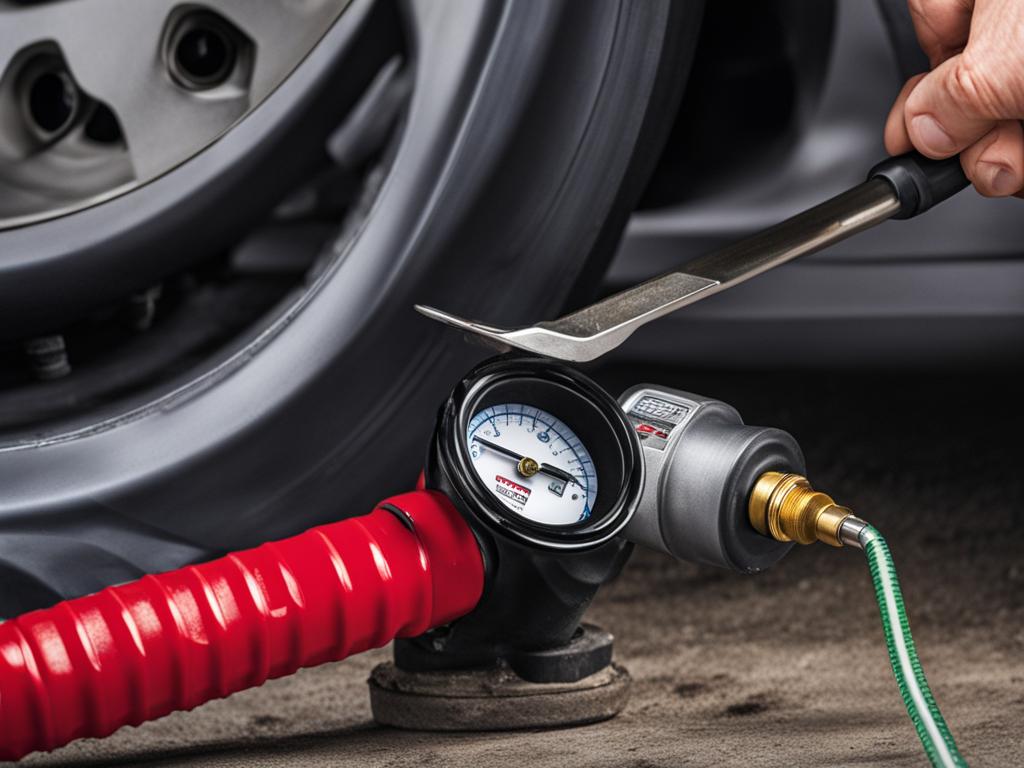
Essential Tools Required for Checking Tire Pressure
Investing in a high-quality tire pressure gauge is necessary for obtaining precise tire pressure readings. Many drivers prefer digital gauges for their ease of use and accuracy, while others appreciate the simplicity and reliability of analog models. Whichever type you choose, make sure it is in good working condition. Additionally, access to a source of compressed air, such as an air compressor at a gasoline station or a portable air pump, is necessary when adjustments are required to maintain proper tire pressure on your Honda Accord.
Identifying the Correct Tire Pressure for Your Honda Accord
The correct tire pressure for your Honda Accord can be found on a yellow and white label located inside the driver’s door frame. This label displays the manufacturer’s recommended tire pressure levels for both front and rear tires to provide the best ride comfort and tire longevity. It’s crucial to follow these recommendations rather than trying to estimate appropriate pressure levels or relying on pressure settings from other vehicle models.
| Model | Front Tires | Rear Tires |
|---|---|---|
| Honda Accord LX | 32 psi | 32 psi |
| Honda Accord EX | 32 psi | 32 psi |
| Honda Accord Sport | 35 psi | 35 psi |
| Honda Accord Touring | 35 psi | 35 psi |
| Honda Accord Hybrid | 32 psi | 32 psi |
With the right tools and a clear understanding of your Honda Accord’s recommended tire pressure levels, you are now prepared to take the necessary steps to check tire pressure on your Honda Accord and maintain proper tire pressure for a safer, more enjoyable driving experience.
The Step-by-Step Process to Check Tire Pressure on Honda Accord
Properly checking tire pressure on a Honda Accord is essential for your safety and the overall performance of your vehicle. Here, we’ll guide you through the process step by step.
- Start by turning the key in the ignition halfway to access the ‘accessory mode’. This action will enable the Tire Pressure Monitoring System (TPMS) light on your dashboard, which will indicate if there’s low pressure in any of the tires.
- Proceed to locate the valve cap on each tire. Remove the cap and keep it in a safe place to avoid losing it.
- Place your tire pressure gauge onto the valve stem, ensuring a firm and air-tight connection. Read the gauge and perform this action multiple times to ensure accuracy in your tire pressure readings.
- If any of the tires need air, use an air compressor to replenish them. Attach the nozzle to the valve stem as you did with the tire pressure gauge and listen for the hiss of escaping air. Fill the tire until the hissing sound is no longer audible.
- During the air-filling process, periodically use your tire pressure gauge to ensure that the tire has reached the appropriate inflation level. Make sure not to overinflate the tire, as it can cause uneven tire wear and affect the handling of your Honda Accord.
- Once you’ve reached the correct tire pressure, replace the valve caps on each tire to secure them properly.
By following these steps, you’ll be able to check tire pressure on your Honda Accord effectively, ensuring a smooth and safe driving experience.
How to Respond to a Tire Pressure Monitoring System Warning
When the Tire Pressure Monitoring System (TPMS) warning light activates on your Honda Accord, immediate action must be taken to ensure the safety and performance of your vehicle. This warning light, appearing as an amber-colored icon on the instrument cluster, suggests that at least one tire may have a pressure issue. Though the TPMS provides an essential alert, it is crucial to perform a manual tire pressure check-up to pinpoint the exact problem and corresponding solution.
Understanding TPMS Alerts on Your Dashboard
The TPMS is designed to detect pressure imbalances or deficiencies in your Honda Accord’s tires. When the system senses an issue, the warning icon illuminates on your dashboard to prompt further investigation. Keep in mind that the TPMS light may temporarily activate during the ignition process as part of the system’s self-check and is not necessarily a cause for concern. However, if the light remains illuminated after the ignition sequence, it is a clear signal to examine your tire pressure.
Manual Check-Up: Ensuring Each Tire is Properly Inflated
To accurately diagnose and resolve a tire pressure issue, a thorough manual check is essential. Utilize a reliable tire pressure gauge to measure the pressure in each tire and identify any discrepancies. This process includes a consecutive sequence of measuring, adjusting with compressed air, and rechecking to ensure each tire is inflated to the correct pressure as recommended by Honda.

By following these honda accord tire pressure tips, you can efficiently and effectively address any tire pressure issue upon receiving a TPMS warning. Ensuring your tires are properly inflated not only contributes to your safety but also promotes optimal performance, fuel efficiency, and the longevity of your tires.
Adjusting Tire Pressure: Adding and Reducing Air Safely
Maintaining proper tire pressure on your Honda Accord is vital for ensuring your vehicle’s safety, performance, and fuel efficiency. Adjusting tire pressure safely requires a careful approach and the use of relevant equipment. In this section, we will dive into some practical tips for using an air compressor effectively and the importance of double-checking pressure after making adjustments.
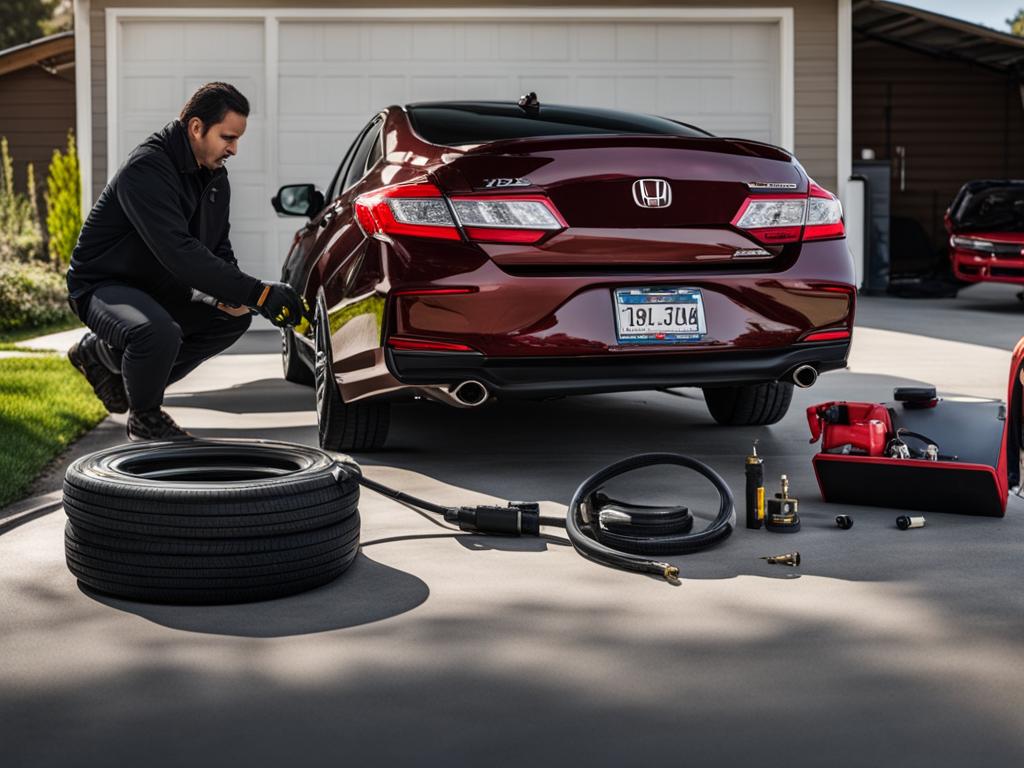
Tech Tips for Using an Air Compressor
When adding or reducing air in your tires, it’s essential to operate the air compressor securely. To do so, follow these guidelines:
- Firmly attach the nozzle to the tire’s valve stem, ensuring no air leakage.
- Periodically assess the tire pressure using a tire pressure gauge to ensure you are reaching the recommended tire pressure specific to your Honda Accord.
- Continue adding or releasing air until the pressure matches the manufacturer’s recommendations.
Double-Checking Pressure After Adjustments
Once you’ve completed adjusting your tire pressure, it’s crucial to double-check that the pressure is within the suggested range. This not only ensures you’ve made the correct adjustments but also guarantees long-term safety and performance. Here’s how to do it:
- Use a tire pressure gauge to check the pressure of each tire again.
- Compare the readings to Honda’s recommended pressure found on the label inside the driver’s door frame.
- If any tire pressures are still outside of the suggested range, repeat the process of adjusting with the air compressor until the correct pressure is achieved.
By following these practical tips and consistently double-checking pressure after adjustments, you’ll be able to maintain proper tire pressure on your Honda Accord for a safe and efficient driving experience.
Frequency and Timing: When to Check Your Honda Accord’s Tire Pressure
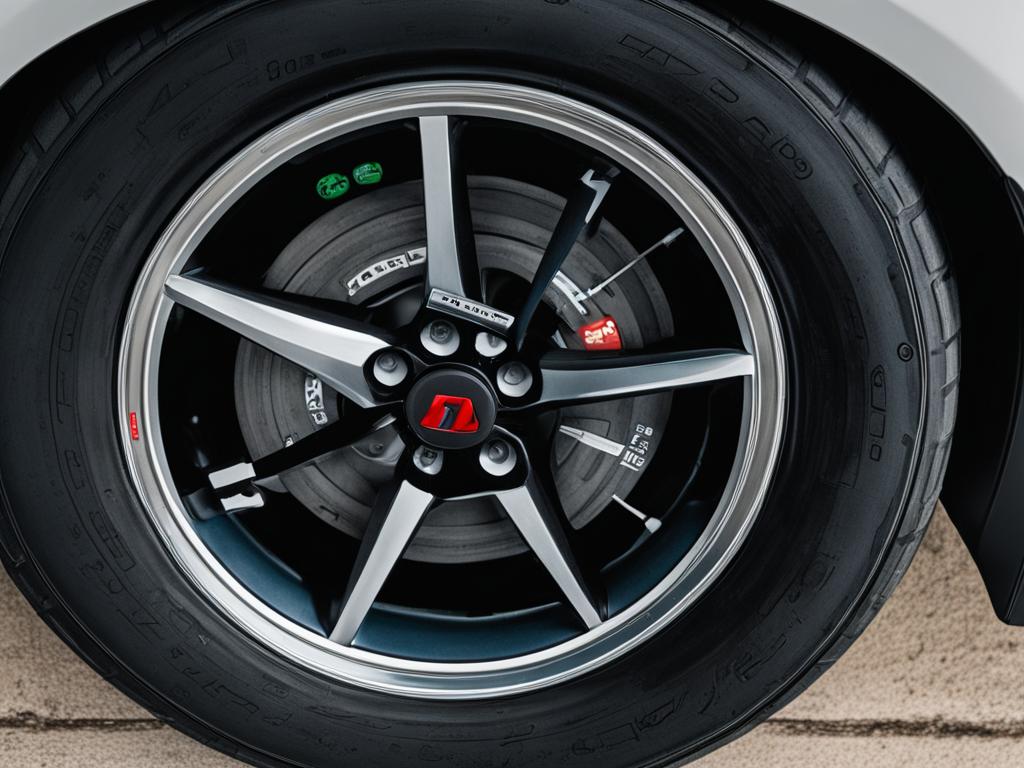
Maintaining optimal tire pressure is crucial for your Honda Accord’s performance, safety, and fuel efficiency. Understanding the recommended timing and frequency for tire pressure checks is imperative to ensure your vehicle’s smooth operation. The honda accord tire pressure recommendations from the manufacturer advocate for regular checks and adjustments to tackle any pressure deviations.
The ideal frequency for tire pressure check honda accord is as follows:
- Every fuel fill-up
- Monthly (minimum)
Despite these suggestions, it’s important to monitor your tire pressure and make adjustments if necessary during significant seasonal changes:
- Extreme temperature fluctuations
- Before extended road trips
- During routine vehicle maintenance
Creating a regular schedule for tire pressure maintenance will yield various benefits, including improved ride comfort, better fuel economy, and prolonged tire longevity. The habit of routinely monitoring your Honda Accord’s tire pressure will not only contribute to its overall performance but also mitigate potential safety risks associated with improper inflation.
| Frequency | Conditions | Benefits |
|---|---|---|
| Every fuel fill-up | Ideal for consistent monitoring | Optimal tire performance |
| Monthly (minimum) | Regular check-up for busy drivers | Adequate maintenance and safety |
| Seasonal changes | Significant temperature fluctuations | Adaptation to environmental variations |
By diligently paying attention to the Honda Accord tire pressure recommendations and following the suggested schedule, you will enjoy an optimally functioning vehicle that both performs well and ensures your safety on the road.
Honda Accord Tire Pressure Recommendations
Ensuring your Honda Accord operates at its peak performance and efficiency involves adhering to specific tire pressure recommendations provided by Honda. These guidelines, which can be found on a label inside the driver’s door frame, are based on various factors, including the vehicle’s load, driving conditions, and tire specifications. Following these recommendations is essential for maintaining proper tire pressure, guaranteeing safety, and extending the lifespan of your tires.
Manufacturer’s Suggested Tire Pressure for Optimal Performance
The recommended tire pressure for the Honda Accord varies depending on the model and year. However, generally speaking, Honda suggests maintaining a tire pressure of approximately 32 to 35 PSI (pounds per square inch) for optimal performance. Adhering to these numbers will not only improve your vehicle’s handling and ride comfort but also contribute to better fuel economy and even tire wear.
How Seasonal Changes Affect Tire Pressure
Seasonal temperature fluctuations can impact your Honda Accord’s tire pressure, as changes in air density are influenced by varying temperatures. This means that during cold weather, your tires may experience decreased pressure, while warmer temperatures can cause an increase in pressure. Being aware of these fluctuations and adjusting your tire pressure accordingly is crucial for maintaining your vehicle’s performance and safety, making it vital to check your tire pressure regularly, especially during seasonal transitions.
FAQ
How often should I check my Honda Accord’s tire pressure?
Ideally, you should check your tire pressure at every fuel fill-up. However, monthly checks are also acceptable. Additionally, it is important to perform pressure checks during seasonal changes, as temperature fluctuations can affect tire pressure levels.
How do I find the recommended tire pressure for my Honda Accord?
The recommended tire pressure specific to your Honda Accord can be found on a yellow and white label located inside the driver’s door frame. This information is essential for ensuring the optimal performance, safety, and longevity of your vehicle’s tires.
What tools are required for checking and maintaining tire pressure on a Honda Accord?
A high-quality tire pressure gauge is essential for obtaining accurate tire pressure readings. Access to an air compressor or other sources of compressed air is also necessary for adjusting tire pressure when needed.
How do I know if my Honda Accord’s Tire Pressure Monitoring System (TPMS) is warning me of low tire pressure?
If the TPMS detects low tire pressure, an amber-colored icon will appear on your vehicle’s instrument cluster. It is essential to manually verify the pressure with a tire pressure gauge for each tire when this warning is activated, as the TPMS only indicates that at least one tire may have low pressure.
How do I safely adjust my Honda Accord’s tire pressure using an air compressor?
Attach the nozzle of the air compressor firmly to the tire’s valve stem without allowing air to escape. Periodically check the pressure with a tire pressure gauge and adjust as needed until the desired inflation level is reached. Always double-check the tire pressure after making any adjustments to confirm it is within the recommended range.
How do seasonal changes affect my Honda Accord’s tire pressure?
Colder weather can cause tire pressure to decrease, while hotter temperatures may cause an increase in pressure. Monitoring and adjusting your tire pressure during seasonal changes is essential for maintaining vehicle performance and safety.


